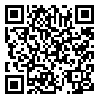Volume 2, Issue 2 (9-2018)
JCES 2018, 2(2): 11-24 |
Back to browse issues page
Download citation:
BibTeX | RIS | EndNote | Medlars | ProCite | Reference Manager | RefWorks
Send citation to:



BibTeX | RIS | EndNote | Medlars | ProCite | Reference Manager | RefWorks
Send citation to:
Jalalzadeh T, Barghian M. Investigation of pre-stressed skewed box-girder bridges subjected to seismic loads. JCES 2018; 2 (2) :11-24
URL: http://journals.lu.ac.ir/jces/article-1-25-en.html
URL: http://journals.lu.ac.ir/jces/article-1-25-en.html
Abstract: (2962 Views)
Earthquakes are the major cause of bridges destruction. It is obvious that the seismic ability of bridges and in general all transportation systems are very important in management of crises. For this reason, the seismic performance and behavior of particular types of bridges have been researched in this study. Skewed bridges are most popular and applicable in the design of highways and inter-city roads. Wherever roads cannot be continued straightly, bridges and in some cases skewed geometry of the bridges are practiced. The design of this kinds of bridges has become a normal practice within engineering communities in recent decades with emphasis on the construction of pre-stressed skewed box-girder bridges due to their characteristics and behavior. In this study three-span pre-stressed box-girder bridges with different skew angles were modeled using CSiBridge software. Seismic analysis was performed on the above-mentioned bridge with different skew angles and demand to capacity ratios for columns and internal forces of deck and columns were extracted from program to find out the general behavior of structure. Results indicate that increasing the skew angle of the bridge decreases the capacity ratio of the columns. An increasing trend is observed for the axial force of columns when increasing the skew angle in first bent columns while the converse is true for the second bent. Shear force in longitudinal direction of the bridge for columns tend to decrease while an increase is noticeable in the transversal direction in first column. Torsional moment in first bent rises in contrast to that of the second bent which declines. Bending moment about transversal axis decreases. For internal forces of deck with increase of skew angle the axial force increases, vertical shear force at beginning of bridge (obtuse corner) increase and at the end (acute angle) decrease. This force reduces on bents and increases in the middle of the bridge. The torsional moment of deck at beginning of bridge increases and at the end of bridge decrease, and at the middle increases. Transversal bending moment of beginning and the end of the bridge decrease and it is increased on bents and in the middle of bridge. Longitudinal bending moment at beginning, end and on bents of bridge decrease and on the middle of bridge increases.
Review Paper: Research |
Subject:
Special
Received: 2018/03/16 | Accepted: 2018/05/26 | Published: 2018/09/18
Received: 2018/03/16 | Accepted: 2018/05/26 | Published: 2018/09/18
Send email to the article author
| Rights and permissions | |
 |
This work is licensed under a Creative Commons Attribution-NonCommercial 4.0 International License. |






